#caster semenya
Text
Champion runner Caster Semenya won a potentially landmark legal decision for sports on Tuesday when the European Court of Human Rights decided she was discriminated against by rules in track and field that force her to medically reduce her natural hormone levels to compete in major competitions.
But the two-time Olympic champion’s success after her two failed appeals in sports’ highest court in 2019 and the Swiss supreme court in 2020 came with a major caveat. The ruling didn’t strike down the rules and the world track and field body said soon after it was released that the contentious testosterone regulations would “remain in place.”
445 notes
·
View notes
Text
Because the average black woman has an extremely high testosterone level?

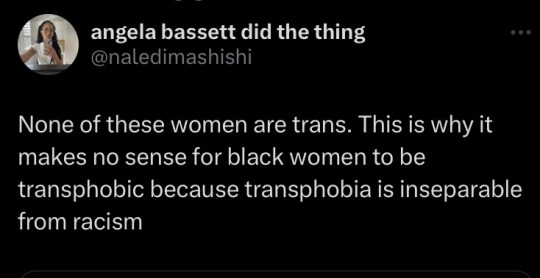
The mental gymnastics from black liberal feminists who support trans ideology is crazy.
Do they realise that they’re entrenching the racist idea that black women are naturally more masculine?
#trans ideology#gender cult#gender ideology#racism#black women#caster semenya#radical feminist safe#radfem#radblr#radical feminism#radical feminists please touch#radical feminists please interact#radfem safe#liberal feminism
234 notes
·
View notes
Text
41 notes
·
View notes
Text
Double Olympic 800m champion Caster Semenya was discriminated against by rules forcing her to lower her testosterone levels in order to compete, the European Court of Human Rights has found.
The 32-year-old South African was born with differences of sexual development (DSD) andis not allowed to compete in any track events without taking testosterone-reducing drugs.
On Thursday the ECHR ruled in favour of Semenya in a case involving testosterone levels in female athletes.
A three-time 800m world champion and 800m and 1500m Commonwealth champion, Semenya has been in a long-running dispute with governing body World Athletics since regulations requiring her to have hormone treatment were introduced by World Athletics in 2018.
[...] An ECHR statement read: "The court found in particular that the applicant had not been afforded sufficient institutional and procedural safeguards in Switzerland to allow her to have her complaints examined effectively, especially since her complaints concerned substantiated and credible claims of discrimination as a result of her increased testosterone level caused by differences of sex development."
16 notes
·
View notes
Text
A category for women, non women and open would help women, people with gender feelz AND people with intersex traits. But TRAs don't actually want to work with women and the intersections community. TRAs just want to use them for woke points.
She’s the Olympic gold-winner whose elevated testosterone levels led people to question her right to compete. With a few choice words for World Athletics, the middle-distance runner talks about labels, leaked medical records and how lowering her hormones took its toll on her body
‘You are here for a gender test’: read an extract from Semenya’s memoir
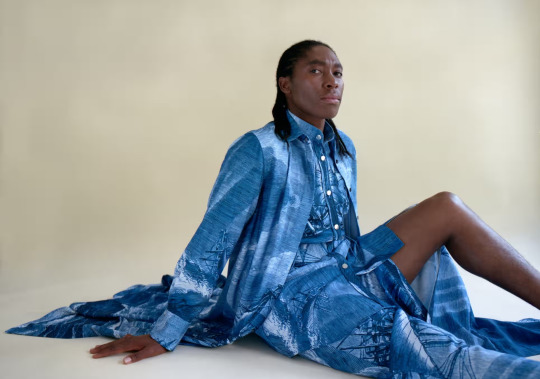
Caster Semenya photographed in Johannesburg, South Africa, earlier this month. Styling: Thomas Van Dyk. Hair and makeup: Alex Botha. Styling assistant: Jade Ayla. Photograph: Alice Mann/The Guardian
Caster Semenya
Caster Semenya: ‘How would I label myself? I’m an African. I’m a woman. I’m a different woman’
She’s the Olympic gold-winner whose elevated testosterone levels led people to question her right to compete. With a few choice words for World Athletics, the middle-distance runner talks about labels, leaked medical records and how lowering her hormones took its toll on her body
Tshepo Mokoena @tnm___Sat 28 Oct 2023
For much of her early 20s, Caster Semenya felt physically sick. The South African runner had risen to sudden global acclaim in 2009, when she won gold in the 800m at the World Athletics Championships in Berlin at the age of just 18. It was her first major world competition. But her win was marred by questions of her sex and gender. Given her speed, muscular build and husky voice, some quietly asked whether she was a man. The sport’s governing body, the IAAF (known since 2019 as World Athletics), had required Semenya to take gender verification tests the day before the race, with a spokesperson telling the press “the rumours, the gossip was starting to build up”, and needed investigating.
Semenya’s subsequent victory would mark the start of a decade-long story, full of twists and turns that would take her from the top of the world championships podium to the European court of human rights – and would lead to a career-defining battle between the runner and World Athletics about her right to compete, as well as a monitored medical treatment plan that would leave her feeling, as she tells me today, “like the walking dead”.
Two sets of test results were leaked in the months that followed the Berlin championships: blood tests reportedly showed Semenya had three times more testosterone in her system than the average woman. Then the results of her medical examinations were published by Australian papers, suggesting Semenya was a “hermaphrodite” with internal testes and no womb. After 11 months of uncertainty, the IAAF announced in July 2010 that they had agreed on a “process” with Semenya, to allow her to compete at elite level (she hadn’t been able to run a race since August 2009 but had kept her first gold medal).
The process was a course of hormonal contraceptives, which neither she nor the IAAF made public. Instead, Semenya says that she had to secretly start taking the hormones at the end of 2009 to bring her naturally high testosterone levels down to a concentration accepted by the IAAF. And it didn’t go well. “I’d describe [the medication’s effects] like this: you’re living every day with a sore body. Your stomach is burning, you’re having panic attacks, you’re sweating. It … it was crazy.” Semenya first used a gel, before switching to a contraceptive pill.
She tells me this over Zoom, where she can be seen sitting outside on a shaded patio in Johannesburg. In a simple gold chain hanging over a white T-shirt and with her hair braided in her signature cornrows, she looks and sounds relaxed. But she also speaks passionately about what she had to endure early on in her career, shifting quickly from niceties about the photoshoot for this interview to torrents of profanity.
At times, she says, while on the hormones from 2009 to 2015, she felt so low she struggled to get up. As a child in the village of Ga-Masehlong, in the remote stretches of South Africa’s northernmost province, Limpopo, she had been a natural sprinter, with early dreams of playing professional football. Running at speed was intuitive. On the medication, though, she felt unstuck in her own body. But lowering her testosterone became the only acceptable way to appease the IAAF and keep competing.
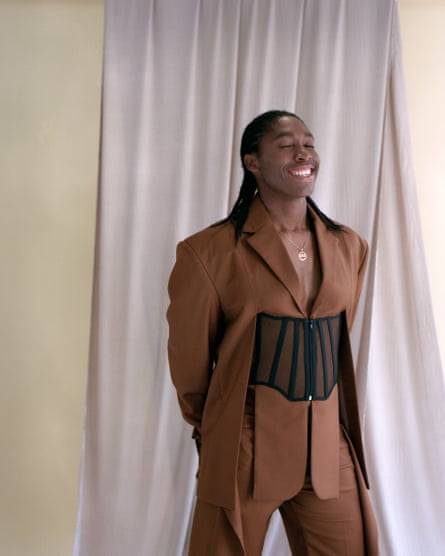
“I had to sacrifice myself to be the best that I am. There were days when I lived in the dark. Days where I didn’t want to wake up,” she remembers. “Those are the things that people don’t understand when World Athletics says: ‘Take this medication.’ Fuck them. Those motherfuckers must go take the medication themselves, then tell us how they feel.” She names both IAAF/World Athletics president Sebastian Coe, whom she calls “this idiot”, and the organisation’s health and science department director Dr Stéphane Bermon. “They’ll say: ‘Oh, these medications were well supervised.’ Fuck it – they don’t know shit about that.”
See rest of article
#Caster Semenya#I feel bad that because of TRAs people with intersex conditions are being dragged into politics#Medications and side effects#She was raised as a girl
8 notes
·
View notes
Text

you'd think they'd get the fucking hint at some point
3 notes
·
View notes
Text
Thought I’d share this poem, given the decision by the American Anthropological Association and the Canadian Anthropology Society.
Semenya eventually appealed to the European Court of Human Rights, and they ruled in her favor—previously she had been told she had to take cancer-causing drugs to suppress her hormones.
8 notes
·
View notes
Text
So apparently right wingers are saying that WNBA player Brittney Griner is a trans woman due to her appereance, voice etc...gross. They did the same to Caster Semenya last year, I hate this.
(to be clear, trans women in sports are a great thing and must be supported, I’m saying this type of transphobia is bad)
33 notes
·
View notes
Text
To me, this was personal. I was the runner closest to the 800-meter world record, and I felt the I.A.A.F. wanted to shut me down. To me, its restrictions aren’t about leveling the playing field; they are about getting certain types of women off the field completely.
2 notes
·
View notes
Text
unlocked article
By Caster Semenya
I know I look like a man. I know I sound like a man and maybe even walk like a man and dress like one, too. But I’m not a man; I’m a woman. Playing sports and having muscles and a deep voice make me less feminine, yes. I’m a different kind of woman, I know, but I’m still a woman.
I began running competitively as a teenager in South Africa, and by age 18 I was competing on the international stage. In 2009, as I prepared to run in the Berlin World Championships, athletic authorities sent me for some medical testing. Because of my looks, there had been speculation from my fellow athletes, sports officials, the media and fans that I was not what I said I was.
I arrived at the medical appointment expecting to be checked for performance-enhancing drugs. Instead, at age 18, I had my first gynecological exam. Afterward, I learned that I had XY chromosomes, rather than the typically female XX pairing, and high levels of testosterone, produced by undescended testicles I didn’t know I had. In order to continue racing as a woman, I was told, I needed to have surgery to remove them. [...]
A gynecologist my team hired examined me and told the I.A.A.F. that if the issue was my testosterone level, estrogen could bring it down to below 10 nanomoles per liter, which is at the low end of the range for male testosterone levels. But my own doctor was worried. There was no research on elite athletes with my specific physical condition taking what was essentially birth control just to run competitively. She cautioned about the possible side effects: weight gain, blood clots, leg cramps, weakening of bones, vaginal bleeding, general feeling of illness, breast swelling, headaches. (A spokeswoman for World Athletics told The Times that athletes are advised to consult specialists to identify how they can comply with World Athletics rules and regulations and said it is not the organization’s role to recommend specific treatments.)
She advised me that I shouldn’t take the medication for more than four years. “You retire at age 21, Caster,” she told me. “Four years. You get one Olympics. Anything beyond that, and you could do irreparable harm to your body.”
I didn’t care about the side effects at the time. I was only 18, I was young and strong, and I thought I could get through anything.
I started feeling sick almost as soon as the medication entered my system. My muscles felt heavy, I was always tired, my head hurt, my brain felt cloudy, and I was nauseated. But after six months of the treatment, my testosterone level dropped to the level that the I.A.A.F. had deemed acceptable, and in July 2010, I returned to the track.
Everyone knew why I’d been absent; the results of the gender tests had been leaked by an Australian newspaper before I had even been told about the findings. I’d been called a hermaphrodite. I had to walk back out into the world with this thing hanging around my neck. I wasn’t oblivious to the stares and whispers from other runners. The media continued to speculate about me and my condition, but I would not speak about it. I wasn’t going to take on an identity that did not fit my soul because some doctors had taken my blood and images of my organs. I was not a hermaphrodite or anything other than a woman. [...]
As I prepared to run at the 2016 Olympic Games in Rio de Janeiro, some said my win in the 800 meters was inevitable — not because I’d been training and running well but because people felt I had an unfair advantage.
Yet they thought nothing of cheering on the seeming inevitability of wins by genetically gifted athletes like the sprinter Usain Bolt, who boasted a stride that was far longer than his peers’. No one suggested Michael Phelps’s dominance in the pool was unfair and he should have to take medication to ensure that he produced just as much lactic acid as his competitors or have surgery to fix his hypermobile joints. The swimmer Katie Ledecky was never accused of being a man because she smashed multiple world records and her ever-improving times in several events would qualify her for the men’s Olympic trials. But they said such things about me because I represented something that was seen as abnormal. [...]
The guidelines announced in 2018 set a maximum testosterone level that was 50 percent lower than even the low level I had taken so many drugs to achieve. And I would have had to achieve and maintain that level for six months before I was eligible to compete. I refused to again subject myself to the mental anguish and physical torture of the poison. I was no longer an 18-year-old girl desperate to run. I was a world champion, an Olympic champion. I had achieved my dreams.
When they announced the regulations in 2018, the I.A.A.F. offered women with D.S.D. who refused the medication but still wanted to compete what it surely felt was a generous and sympathetic offer: We could change our distances, run any distance we wanted in the male category or run in some future intersex category, should it ever become available.
Both of these suggestions are insulting. I am not a man. I have spent years in legal battles, fighting to be able to race without restrictions. But today I could compete only if I altered my hormone levels. For me, participating in a third category of human gender identity would be accepting being othered, accepting the discrimination that I had fought against. It would mean giving up the identity I’d been born with and had never questioned to take on a new one I didn’t believe. Even though I understand that those in the medical community call me an intersex person because of the way my internal organs are structured, I do not call myself intersex. That identity doesn’t fit me; it doesn’t fit my soul.
(emphasis mine)
#caster semenya#women in sports#that line from the world athletics spokesperson is a joke lmao#you're in people's business but don't care to help them safely achieve your silly guidelines#read the full piece pls i couldn't fit everything in
3 notes
·
View notes
Note
Look, I think what the anons discussion with you about Caster don't get that she is on all levels, except chromosomal and organ-wise, a female. She has the anatomy of a woman - primary and secondary sex characteristics - and, what's even MORE important - HORMONAL LEVELS of a woman. The only difference between her and any other woman is that she has internal testicles and a Y chromosome.
With that anatomy, as well as her hormone levels, she is more than likely infertile 100%. Internal male organs are not likely to produce sperm to begin with. Especially coupled with female hormone levels. He'll, even external, usual male genitalia stops working once you add a lot of estrogen, which is why mtf people tend to freeze their sperm if they want biological offspring. And their hormone levels are never even close to those of a woman.
Yes, Caster might be an intersex male. But without modern science, there would be no way to know. There is no hormonal advantage or something else that you could see from the outside.
100 years ago, we would not have known that Caster is, genetically, a male, because Caster has no advantage on a physical scale over regular women. We all would've just thought of her as infertile.
Based on hormone levels alone, she doesn't have the characteristics associated with testosterone. Like stated above, no physical advantage. But also no raised level of physical aggression. She probably even has the same cycles in estrogen levels as any other woman. Because if not, she would struggle a lot without adding hormones from outside. Or she would have had raised testosterone levels, which she doesn't.
Yes, technically, Caster is a male. However, she exists on all scales as a female. She gets perceived like a female and has the same body composition as a female. She physically performs like a female. And probably smells like one, too (bc pheromones).
Do you guys think that normies really care that she has internal testicles? Do you think people cared when she grew up as a woman, went to an all girls school, etc? Do you think that she didn't suffer the same socialisation and discrimination like all of us?
It's more likely that she got hated on even more after it turned out that she is actually male. Because she is both a "faulty woman" and a "disgrace to men", depending which misogynistic angle you want to take to look at her.
The fact that so called "radical feminists" go after her like this is appalling to me as well. Like, y'all always advocate for not misusing intersex people for arguments or shunning them for being intersex. Y'all make a point of listening to our intersex sisters.
But then you decide that a woman is not our sister because she has different chromosomes and is infertile? Because technically, on a minor, non-observable scale (unless you use ultra sounds and genetic testing), she is a man?
Look, I get it. Bioessentialy speaking, she is a male. However, there is not a single area in her life where she didn't live and breath the female experience. And if you'd ask her, she would probably tell you that it was hard for her to find out that she's actually not a "real" female. Just put yourself in her shoes for a goddammn minute. I'm a misandrist myself, but you are just taking it to another, arbitrary level, gyns.
god i wrote a long asf reply but tumblr crashed. ill try to quickly reiterate what i had said:
i need to correct you here: caster semenya DOES have higher testosterone levels than the average woman. this is not unusual for female athletes though, as they often do have generally higher testosterone levels than the average woman:

the reason semenya is unable to compete is basically to do with her being intersex & her hormone levels being above 5 nmol/L. this limit placed is above the female average, however it is lower than the male average:

now, while males often do have a physical advantage to women, some people here seem to believe that XY chromosomes = immediately has an advantage over women in sports (false). and testosterone levels = immediately gains positive effects of testosterone like higher muscle mass or strength or speed. this is ignorance. in intersex XY women, the testosterone produced often doesn’t work the same way it does for the average male. it’s unclear what exact intersex condition caster semenya has (could only find she has 46, XY), but several people mentioned that she potentially has 5-ard. in the case of 5-ard, they lack the enzyme to convert testosterone to DHT:
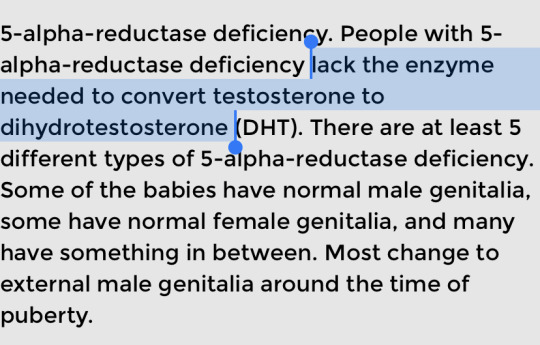
based on the research i just did, DHT’s exact role is still unclear and it has still not been researched enough. however, it does seem to play a role in muscle mass and strength (one of the largest advantages males have over females in sports):


it’s also vital for bone density (another major sex difference):

this means even with higher than avg testosterone levels, the testosterone in those with 5-ard is unlikely to function the same way it would in a regular male or even a regular female, because it cannot be converted into DHT.
DHT also seems to translate into higher endurance:

this means that DHT was found to be quite crucial to many (if not all, we don’t know) advantages males have over females in sports.
another 46, XY intersex condition where testosterone won’t function the same way is AIS:
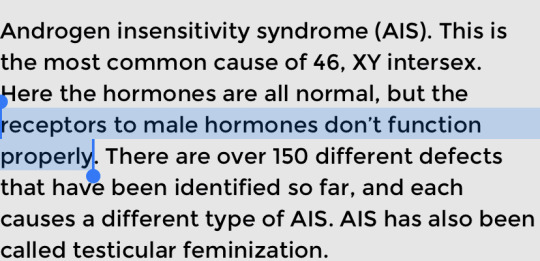
what i have mentioned above is why intersex women should be evaluated on a case by case basis. caster semenya, based on what we know, has regular female genitalia. many with 5-ard will develop male genitalia around puberty, and yet she hasn’t. this alone tells me IF what she has is 5-ard, people with said disorder shouldn’t be grouped as the same and instead individually evaluated, as there is likely to be some unexplained reason why she specifically has female genitalia despite having reached puberty. some intersex women & men may have advantages, some may not. they shouldn’t be excluded on the basis of their chromosomes for “fairness”, bc there’s nothing fair about that. they should be thoroughly evaluated in a manner which will tell us whether or not they, personally, have an advantage.
i also want to once again highlight that these criterias so far have been disproportionately (ie exclusively) targeted black women:

23 notes
·
View notes
Text
i feel bad for caster semenya. shes not even trans. nor did she do anything bad. she excelled!!! that takes hard work!!!! but governing bodies from other countries are trying to force her to do something with her body she doesnt feel comfortable with. theyre trying to invade her bodily autonomy, in a medical way.
i kinda wonder if this gatekeeping would happen if caster semenya was white? you know what i mean?
2 notes
·
View notes
Text

Rainbow families: 6 South African queer celebrity parents
7 notes
·
View notes
Text
Remember when I said TERFs are nothing more than white supremacists (barely) in disguise?
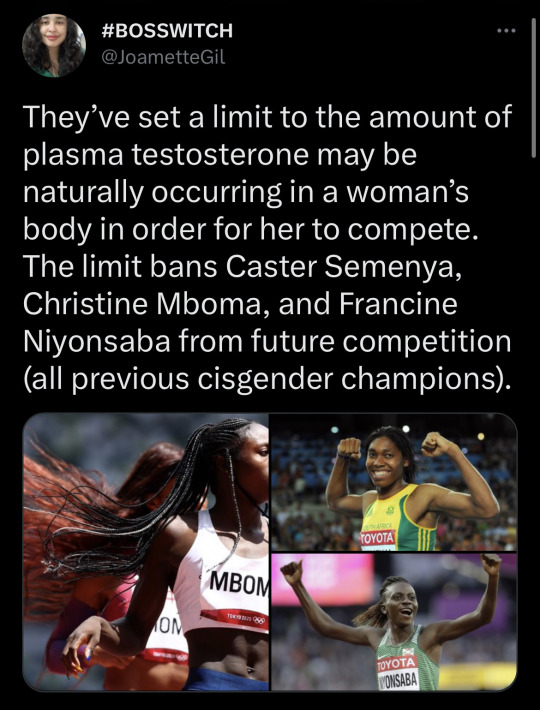
They got a victory in banning cis-women from women’s athletics. Weird though how the ban and its phrasing only applies to three active Black female athletes.
Things like this will keep happening because their standard for what a woman is a white woman and will never account for the biological variables that exist within other races. That is intentional and will always exist because the basis of TERFism is white supremacy.
But we’re protecting women’s sports. Yeah sure, you fucking bigot.
And as always, if you’re a TERF or believe any of their ideologies get off my blog and block me before I find and block you.
#tired of their shit#caster semenya#christine mboma#francine niyonsaba#oh no white women can’t win because the black women are born different#so was michael phelps but hey that’s okay because he looks like us#they tried to test the shit out of usain and Veronica and SFP too#because god forbid black people are good at things and aren’t the perpetual underdogs y’all want us to be
6 notes
·
View notes